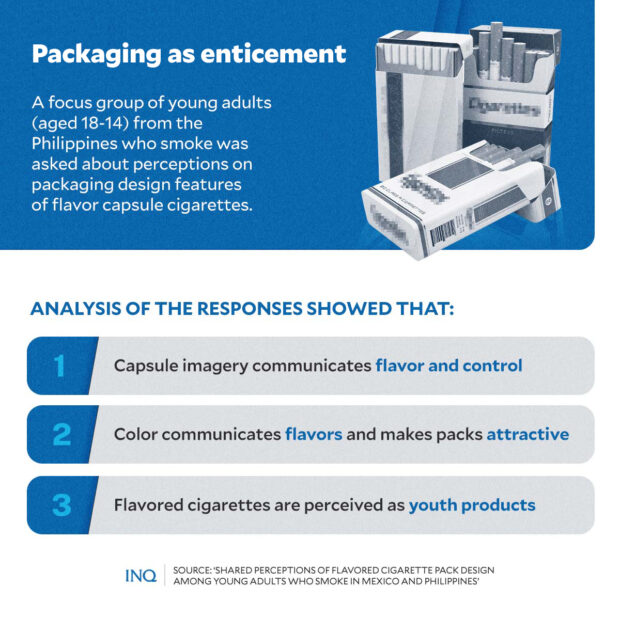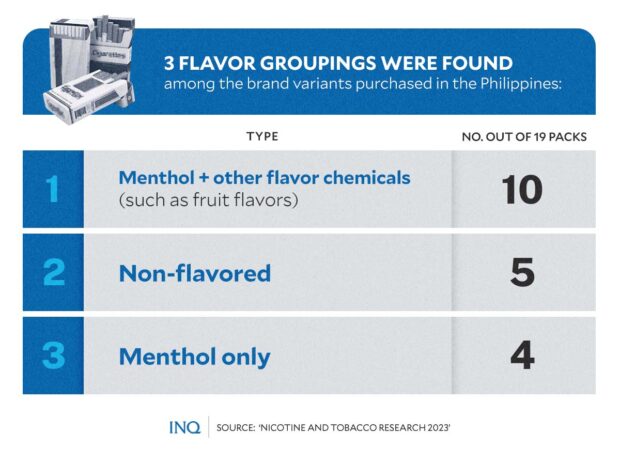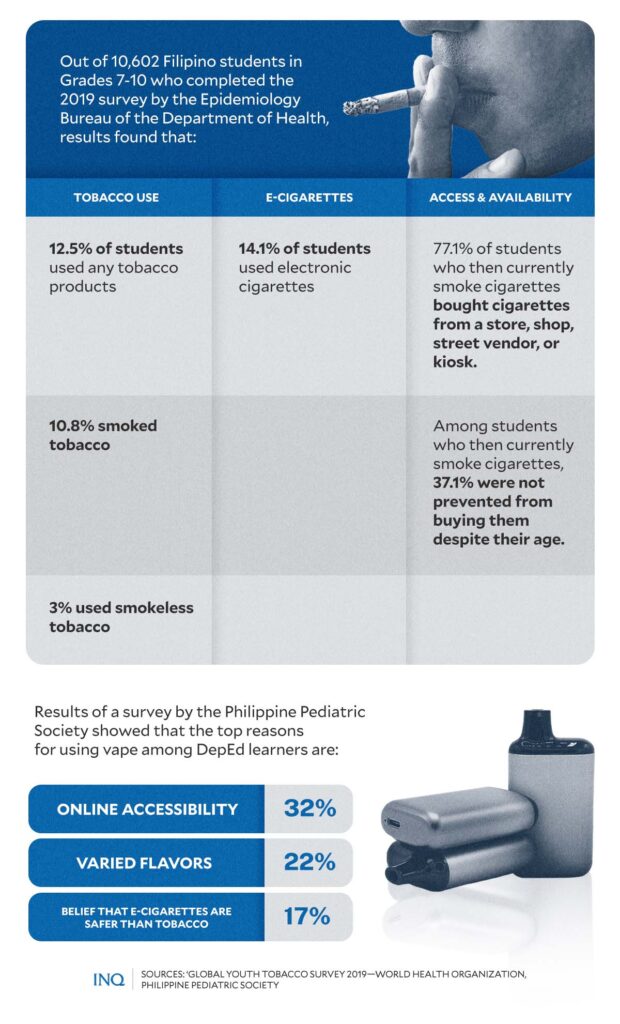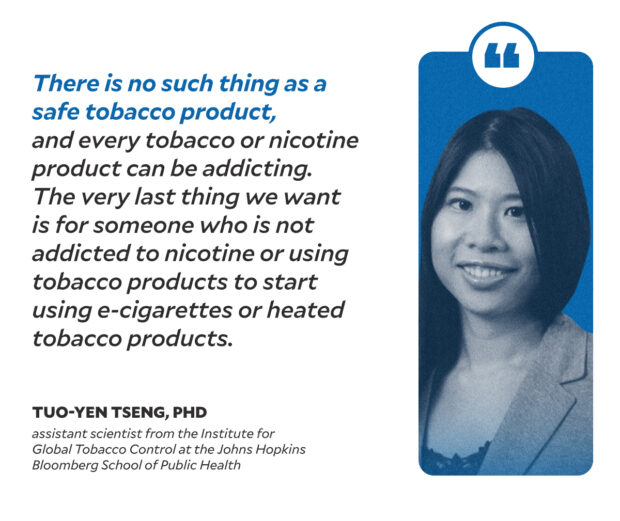(Second part)
First part: Vape: Flaws in law worsening youth ‘vapedemic’
MANILA, Philippines—“There are a lot of colors[;] it looks like a candy,” said a focus group participant from the Philippines, around age 18 to 24, to researchers for a study analyzing packaging designs and marketing approaches for a specific product.
Two other respondents said: “The ones we deemed attractive are colorful” and “The brand is really affordable, but the flavor makes it more appealing to the younger ones.”
INQUIRER.net randomly asked some individuals to guess the product being described for the study.
“It must be for food. Maybe ice cream?” said Gelo Regalado.
Matthew Espiritu, another respondent, said in Filipino: “What I thought of is the rainbow sour tape,” referring to a type of candy sold locally.
Two interviewees took a different route with their guesses: “Condom,” said Francis Devocion, while Nathan Busmente quickly answered in Filipino: “Medicine.”
The guesses were made based on keywords and phrases from the focus group participants’ responses, which included “colorful,” “flavor,” and “appealing to young ones.”
Participants linked the words to youth appeal, but none were able to correctly guess what product was being referred to.
The study by scientists at the Johns Hopkins Bloomberg School of Public Health examined young adults’ perception of flavored cigarette packs, including those with flavor capsules, sold in the Philippines and Mexico.
According to the study, transnational tobacco companies (TTCs) have aggressively invested in increasing tobacco sales in low- and middle-income countries.
Among the marketing strategies applied by tobacco companies to further promote their products are packaging design features, which target young adults who smoke and young people who have recently started smoking.
“TTCs target specific consumer groups, associate their brand with core values held by young adults, and influence perceptions of harm, appeal, and expectations about the product,” the scientists explained.

GRAPHIC: Ed Lustan
Individuals from 18 to 24 years old from both countries, who smoke, had been selected and separated into groups and asked to interact with cigarette packs purchased locally.
According to the scientists who conducted the study, three major themes were identified in the analysis:
“Young adults who smoke in Mexico and the Philippines interpreted flavored cigarette pack design features similarly and agreed that younger people, like themselves, are the main audience for these products,” the study said.
“In both countries, participants indicated that flavor capsule cigarettes appeal to people who are experimenting with smoking, newer to smoking, and occasionally smoke,” it added.
Read more about the study here: Tobacco packaging: Getting PH youth hooked on smoking, vaping
The study said flavored cigarettes play a role in turning on to smoking young adults who are in search of their identities.
“The participants in this study also talked about the use of flavor capsule cigarettes in social settings, such as school and parties, with their peers,” the scientists said.
“This could impact smoking behaviors among young people if there is acceptability and likeness by their peers, reinforcing social norms around smoking and contributing to their identity formation as people who smoke,” they added.
While one study pointed out how flavored cigarette packs use colors and flavor capsules to attract young smokers, a separate study focused on how flavor chemicals in tobacco products get adolescents to smoke and how they get hooked.
In a “first of its kind” study, scientists from the Institute for Global Tobacco Control (IGTC) at the Johns Hopkins Bloomberg School of Public Health and Portland State University analyzed the chemical compounds found in flavored cigarette products available in the Philippines.
The scientists said flavored tobacco products continue to be unrestricted in a market where smokers are as young as 15-years-old “presumably to maximize cigarette sales.”

GRAPHIC: Ed Lustan
The Philippines is signatory to the World Health Organization Framework Convention on Tobacco Control (FCTC), which states that “there is no justification for permitting the use of ingredients, such as flavoring agents, which help make tobacco products attractive.”
Results of tests made on 19 brands of locally available cigarettes found three dominant flavors:
IGTC scientists said menthol cigarettes in the Philippines enjoy among the largest market share in the world. It cited the 2015 Philippines Global Asia Tobacco Survey that showed 52 percent of smokers had chosen menthol cigarettes for their most recent purchase.
“Menthol can make cigarettes more palatable,” the scientists said. Menthol, they added, “can contribute to a lower likelihood of quitting.”
Tests also showed the presence of OFCs in different cigarette brands available in the Philippines.
Read more about the study here: Flavor chemicals: Culprit behind PH ‘tobacco epidemic’
The study findings also indicated that flavor “technologies”—capsules and threads—are readily available.
“Evidence indicates that flavor chemicals, including fruit flavors, menthol and clove, and flavor capsule cigarettes, are appealing to young people,” the IGTC scientists said.
Flavor descriptors are not only used to increase the appeal of cigarettes among Filipino youth.
Another study by IGTC said many sellers commonly apply marketing strategies aimed at the youth.
IGTC looked at 15 websites—12 e-cigarettes and three HTP brands—in September 2022 and found that all cater to users in the Philippines.
Analysis found flavor descriptors being used in all 15 brands. The most common is mint or menthol.
A play with words also draw the youth like “Grape Ice,” “Menthol Plus/Xtra”, “Papa’s Harvest”, or “White Freeze.”

GRAPHIC: Ed Lustan
All 15 sites were also found to have used other ad gimmicks like text messages and images depicting flavor, innovation, luxury status and feminine appeal.
IGTC also found that all sites carried marketing messages like:
“There is no such thing as a safe tobacco product, and every tobacco or nicotine product can be addicting,” said Tuo-Yen Tseng, Ph.D., assistant scientist of IGTC at the Johns Hopkins Bloomberg School of Public Health, in an exclusive email interview with INQUIRER.net.
“The very last thing we want is for someone who is not addicted to nicotine or using tobacco products to start using e-cigarettes or heated tobacco products,” Tseng said.

GRAPHIC: Ed Lustan
“These products should only ever be used to reduce current use of nicotine, not start it,” she said.
In the Philippines, advocates of Republic Act (RA) No. 11900 or the Vaporized Nicotine and Non-Nicotine Products Regulation Act had stated that the law provides comprehensive restrictions on the trade of vape products and, most importantly, protect minors from the harmful health impacts of vaping and smoking.
READ: Vape law to regulate new products, save adult smokers and protect minors – advocates
Philippine E-cigarette Industry Association (PECIA) president Joey Dulay also said RA 11900 will regulate the industry for the welfare of consumers.
Section 12 (j) of RA 11900 states:
“The sale of Vaporized Nicotine and Non-Nicotine Products and Novel Tobacco Products that are packaged, labeled, presented, or marketed with flavor descriptors that are proven to unduly appeal particularly to minors shall be prohibited.”
“A flavor descriptor is presumed to unduly appeal to minors if it includes a reference to a fruit, candy brand, dessert, or cartoon character.”
The 2019 Global Youth Tobacco Survey found that around 11 percent of students in the country use tobacco, 10 percent smoke cigarettes, and 14 percent use electronic cigarettes (e-cigarettes).
Data from the Philippine Pediatric Society showed that 11 percent of students aged 10 to 15 years old have already tried vapes. The Department of Education (DepEd) also reported that 6.7 percent of Grades 7 to 9 students were found to “have tried and are using e-cigarettes.”
READ: Senators fume over vape industry’s targeting the youth market, urge DTI to uphold law
Tseng said there is over 100 years’ worth of research showing the dangers of cigarettes while vapes, e-cigarettes, and HTPs have not been as extensively studied, “but we do know that they contain addictive levels of nicotine and that there are other potentially toxic chemicals among their ingredients.”
“We also know that the advertising reach of these products extends beyond people who are trying to quit smoking and attracts new consumers to these dangerous products.”
(Next: Calls for comprehensive ban; how efforts by a local government agency protect youth from damaging impacts of smoking and vaping.)